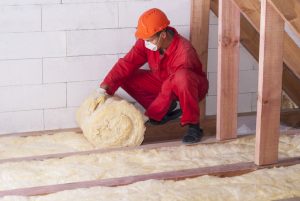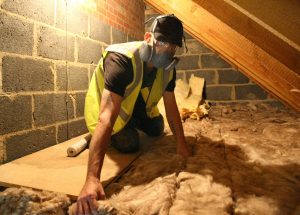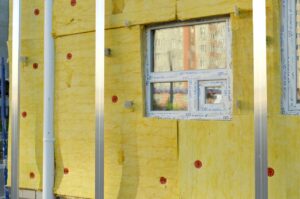Why Loft Insulation is Worth it
Up to 25% of heat loss happens through the roof of an uninsulated home. Installing loft insulation can considerably reduce heat loss, keeping your home warmer in winter but also helping to keep your home cooler in summer by reducing heat getting in. In addition to saving energy, proper insulation can both reduce your carbon footprint and help you make the most of energy efficiency grants from the government.
To learn about grants and funding options, visit our Energy Efficiency Grants page.
Types of Loft Insulation
Loft insulation comes in many forms, each with its own benefits and suitability depending on your home’s needs:
1. Blanket Insulation (Rolls)
Blanket insulation, often made of fibreglass, mineral wool, or sheep’s wool, is one of the most popular and cost-effective choices.
- Pros: Affordable, easy to install, and widely available.
- Cons: Not ideal for unusually shaped lofts or especially small loft spaces.
- Best For: Standard loft spaces.

2. Loose-Fill Insulation
Loose-fill insulation is made up of small particles of material like cellulose, fibreglass, or mineral wool that can be spread across the loft floor.
- Pros: Great for unusual or awkward spaces.
- Cons: Can move over time and may need more regular maintenance.
- Best For: Lofts with uneven surfaces or limited access.

3. Sheet Insulation
Rigid boards, made from materials like polystyrene, provide excellent thermal performance. Sheet insulation is often used in loft conversions where the space will be used as a living space.
- Pros: High thermal efficiency and very durable.
- Cons: Expensive and more difficult to install.
- Best For: Loft conversions or areas needing structural support.

4. Reflective Foil Insulation
Reflective foil insulation is designed to reflect heat, making it especially effective in warmer climates or for preventing overheating. This is generally a less useful insulation in the UK.
- Pros: Lightweight and easy to install yourself.
- Cons: Less effective in colder climates.
- Best For: Homes in areas prone to excessive heat.
Choosing the Right Insulation
Choosing the right type of loft insulation is not an instant decision. It depends on various factors, including your budget, your loft’s structure, the space’s purpose, and your long-term energy-saving goals.
1. Budget
Your budget plays a big role in determining the type of insulation you choose. Blanket insulation is one of the most cost-effective options and works well for quick and easy installations. If you’re looking for more long-term solutions and don’t mind paying for a professional, such as spray foam or rigid boards, be prepared for higher upfront costs, but keep in mind the potential long-term savings due to their better thermal efficiency.
2. Installation Difficulty
The complexity of your loft space determines whether you can install the insulation yourself or need professional help. If your loft is spacious and has evenly spaced joists, you may be able to lay blanket insulation rolls as a DIY project. However, for lofts with unusual shapes, tight spaces, lots of gaps or sloping roofs, you might need a more specialised solution like loose-fill or spray foam insulation, which is usually safest being installed professionally. It is also key to note that some insulation types are not safe to install without substantial safety equipment. If you are not experienced in installing insulation or confident to do so, get in touch with us.
3. Purpose of the Loft Space
The expected use of your loft is another key thing to consider when choosing the right insulation.
- For Storage: If you’re using your loft primarily for storage, you’ll want insulation that doesn’t restrict access and doesn’t shed or require covering. For example, rigid sheet insulation can be installed beneath the floor, providing thermal efficiency while maintaining a flat surface for storage.
- For Living Areas: If your loft is converted into a living space, such as a bedroom or office, you’ll need high-performance insulation like spray foam or rigid boards that can be installed between the rafters to create good thermal performance, without taking up floor space.
4. Existing Insulation
If your home already has some insulation in place that isn’t doing its job, the type of insulation you have and what kind of condition it’s in might affect your decision on which new insulation to fit. In some cases, you can top up existing insulation with blanket rolls or loose-fill material to improve efficiency. However, if the existing insulation is old, thinning or damaged, you may need to remove it and start fresh with a more effective option.
5. Environmental Impact
For those who wish to be more eco-conscious, the environmental impact of the insulation material is an important factor (as it should be for everyone). Sustainable options like sheep’s wool or cellulose, which is made from recycled paper, are great choices for reducing your carbon footprint. While these may come at a slightly higher cost, they do align with environmentally friendly living and are very effective at reducing your heating costs.
6. Long-Term Goals
Think about how long you plan to stay in your home and your energy efficiency goals. If you’re aiming for maximum savings and minimal maintenance over time, investing in higher-quality solutions like spray foam or rigid boards may be worth it. On the other hand, if you need a quick and budget-friendly improvement for a property you plan to sell, blanket or loose-fill insulation may be the best option.
Getting Expert Advice
Choosing the right insulation can feel overwhelming, but you don’t have to make the decision alone. At Lifetime Savings, we offer expert advice and guidance tailored to your home’s specific needs, just get in touch!
How Loft Insulation Saves You Money
Investing in loft insulation can pay for itself in just a few years through energy savings – on average, you can save up to £350 per year on energy bills as well as making your home that bit more comfortable and
To see how much you could save, check out our Savings Calculator, for more tips on energy-saving solutions and grants, explore our Home Energy Savings Blog or get in touch with us for more information on grants for loft insulation.